
Salvia mellifera is a small, highly aromatic, evergreen shrub of the genus Salvia native to California, and Baja California, Mexico. It is common in the coastal sage scrub of Southern California and northern Baja California. Black sage has a dark appearance, especially during drought.

Salvia leucophylla, the San Luis purple sage or gray sage, is an aromatic sage native to the southern coastal mountain ranges of the Californias.

Salvia fruticosa, or Greek sage, is a perennial herb or sub-shrub native to the eastern Mediterranean, including Southern Italy, the Canary Islands and North Africa. It is especially abundant in Palestine, Israel and Lebanon.

Salvia desoleana is a herbaceous perennial shrub native to the island of Sardinia in the Mediterranean. It is endemic to four or five specific locations on the island in sunny locations on limestone, granitic, and igneous rock. Salvia desoleana was named for the botanist Luigi Desole, and was first described in 1982.

Salvia holwayi is a herbaceous perennial native to Guatemala at elevations of 3,000–9,000 feet and at similar elevations in the Mexican state of Chiapas, where it frequently makes an understory in mixed pine and oak forests and thickets. It was named after 19th century plant and fungi collector Edward Willet Dorland Holway.

Salvia karwinskii is a perennial shrub native to the moist mountain forests of Mexico, Guatemala, Honduras, El Salvador, and Nicaragua, typically growing in or near pine or oak forests at 4,000 to 8,000 feet elevation. It is known as a honey-producing plant in those areas, but is rarely seen in private gardens. Specimens are grown at Strybing Arboretum, Huntington Botanical Gardens, and University of California Botanical Garden.
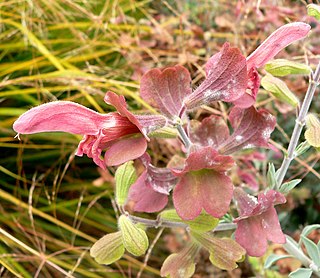
Salvia lanceolata is a perennial shrub native to a small area of coast on the Cape of Good Hope in South Africa. It is typically found growing in sandy ground at sea level, and on dry hills and flat ground up to 1000 feet elevation. Jean-Baptiste Lamarck, a pioneer in evolutionary theory, first described and named the plant "lanceolata" in 1791. Swedish botanist Carl Peter Thunberg, who was delayed in South Africa on the way to Japan, first collected it nearly twenty years earlier, along with approximately 3,000 plants that he later described. It wasn't until 1800 that Thunberg gave the plant the specific epithet "nivea", meaning 'snowy' in Latin, referring to the color of the foliage. Because of the rules of nomenclature, Lamarck's name had precedence because he was the first to name it.
Salvia littae is a herbaceous perennial native to the Mexican state of Oaxaca, growing at elevations of 8,000-10,000 feet. The plants typically grow in some shade in groups at the edge of moist oak forest, or cloud forest.
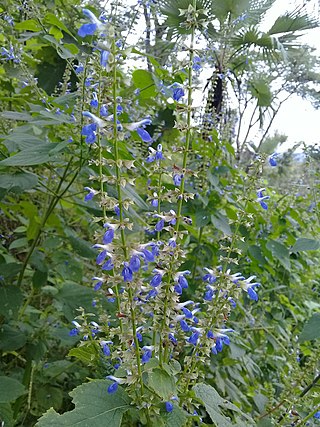
Salvia longispicata is a perennial shrub native to southwestern Mexico, growing between 1,000 and 6,500 feet elevation. The specific epithet "longispicata" gives the impression that the plant has "long spikes", but instead refers to the many projecting clusters of short flowering spikes that resemble small ears of corn.
Salvia lycioides is a perennial native to a wide area ranging from west Texas and New Mexico in the U.S., south through Mexico to the state of San Luis Potosi. It typically grows on dry limestone hills and canyons above 5,000 feet elevation. It was named in 1886 by Asa Gray, the most respected American botanist of the 19th century. The specific epithet, "lycioides", from the Greek, is due to the plant's resemblance to Lycium, a genus also known as "boxthorn" in the nightshade family.
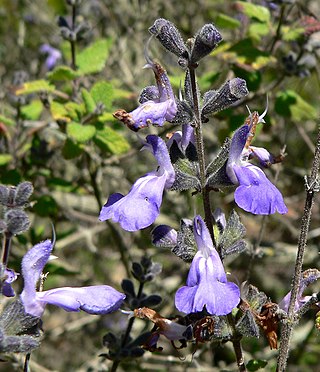
Salvia melissodora is a woody perennial shrub native to elevations from 4,000 to 8,000 feet in the Sierra Madre Oriental mountain range in Mexico found by Diana Arias, from Chihuahua in the north to Oaxaca in the south. The plant is also called tarahumara, after the Tarahumara who have used the leaves and seeds for medicinal purposes for several hundred years.
Salvia merjamie is a herbaceous perennial plant that is native to the east African highlands from Ethiopia to Tanzania, and also across the Red Sea in Yemen. It grows between 6,000 and 13,000 feet elevation in grasslands, forest edges, rocky outcrops, basalt slopes, and fallow fields. The specific epithet merjamie is derived from meryamiye, the Arabian common name for the plant, which is shared with other local Salvia species such as Salvia lanigera. The Maasai common name for S. merjamie is Naingungundeu, meaning that the plant smells of rats, though the variety that is common in horticulture is named 'Mint Sauce' and is described as having a strong minty aroma. S. merjamie shares a similar distribution with Salvia nilotica, though they are not known to hybridize.
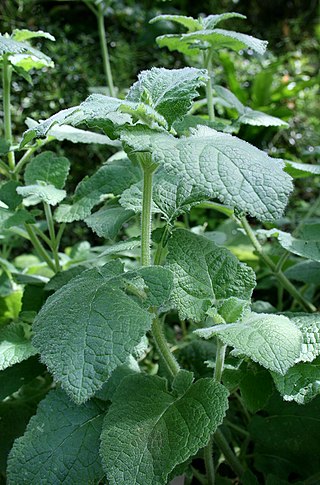
Salvia przewalskii is a herbaceous perennial plant native to the Chinese provinces of Gansu, Hubei, Sichuan, Xizang, and Yunnan, typically growing along stream banks, forest edges, among shrubs, and on granitic hillsides. It was described and named in 1881 by the Russian botanist Carl Maximowicz after the Russian explorer and botanist Nikolai Przhevalsky, who made several collecting trips to China in the 19th century. The plant is widely known throughout its native habitat for its medicinal properties.

Salvia regla is a deciduous perennial that is native to a small area of the Chisos Mountains in west Texas and a large area of Mexico, in the states of Coahuila, Durango, and Oaxaca. The specific epithet is probably from the town of Regla in the state of Hidalgo. It is also referred to as the "queen of the Chisos Mountains". It has been widely planted along the Texas flyway for migrating birds, and is an important food source for hummingbirds returning to the tropics in September and October.
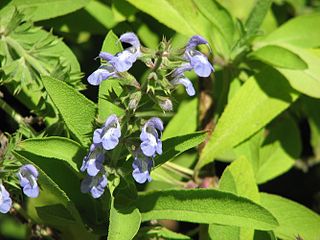
Salvia somalensis is a perennial shrub endemic to a limited range and elevation in Somalia. It grows at elevations from 4,000 feet (1,200 m) to 7,000 feet (2,100 m), typically in forest clearings or edges as a common or dominant subshrub.
Salvia staminea is a herbaceous perennial shrub native to a wide area in Asia Minor that includes Turkey, Georgia, Armenia, and Iran, where it grows at elevations from 6,000 feet (1,800 m) to 14,000 feet (4,300 m). It is typically found growing in alpine meadows, screes, and cliffs, sometimes growing with scrub oak. Due to the wide variety of habitats in which it is found, there is a wide degree of variation in the species. It was first described in 1836 and has only slowly come into use in horticulture.
Salvia stenophylla is a perennial shrub native to a wide area of Southern Africa: South Africa, Botswana and Namibia. It grows on grassy or stony slopes, and in open countryside or among shrubs. It has been used traditionally as a disinfectant by burning it in huts after sickness, and it is also mixed with tobacco for smoking. Its specific epithet, stenophylla, refers to the narrow leaves.

Salvia thymoides is an evergreen perennial shrub native to a small region in Mexico on the border of Oaxaca and Puebla states, growing at elevations from 7,000 feet (2,100 m) to 9,000 feet (2,700 m). Its native habitat is cloud forest, with the mountains catching regular moisture in the form of fog and rain. The plant was named by the botanist George Bentham in 1833, with the specific epithet, thymoides, referring to the small leaves which resemble those of thyme. It has a limited use in horticulture, introduced in the 1980s.
Salvia villosa is a herbaceous perennial that is native to the Mexican states of San Luis Potosi and Coahuila, growing at approximately 4,000 feet (1,200 m) elevation in dry areas that have little or no frost.
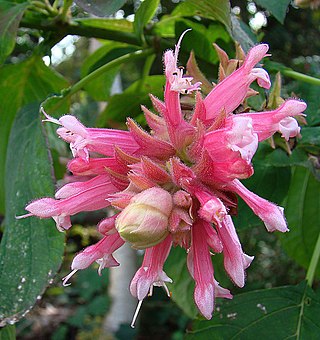
Salvia wagneriana is a perennial found in Nicaragua, Costa Rica, Guatemala, El Salvador, and the Mexican state of Chiapas, growing at 4,000 to 6,500 feet elevation in warm, moist areas. It is very popular among gardeners near its native habitat, and one of the few native plants taken from the wild by local gardeners. It is described sometimes as a herb and sometimes as a shrub by various botanists.














